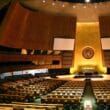Blueprint for avoiding crisis
By Maryam Javan Shahraki, November 20, 2012
Forty-two years ago, amid the Cold War, the Nuclear Non-Proliferation Treaty (NPT) came into force. The treaty's original purpose was, among other things, to prevent countries like Italy, West Germany, and Japan from building nuclear weapons. But since the end of the Cold War, the goal has evolved into maintaining the global nuclear order. Today, the NPT has 189 signatories and is the arms control treaty with the greatest international acceptance. But the treaty's success in stopping the spread of nuclear weapons is debatable, and serious questions surround the NPT's credibility and effectiveness as the world's central mechanism against further proliferation.
When considering these issues, it is useful to keep in mind just how dangerous a nuclear crisis can be. This year marks the 50th anniversary of the Cuban Missile Crisis, which brought the world to the brink of nuclear catastrophe. The world survived — but there is no guarantee it would survive a similar crisis in the future. Indeed, the key lesson of the Cuban Missile Crisis is the importance of preventing a crisis through diplomatic and political efforts before the brink of nuclear war is reached. No matter how imperfect the NPT might be, the treaty still represents a crucial diplomatic tool for anticipating and preventing nuclear crises.
Credibility challenge. Few people dispute that the treaty is necessary; instead, the crucial challenges that it faces involve its effectiveness and credibility. The treaty need not be changed or replaced but, if it is to meet its global objectives, it must be implemented fairly.
One crucial issue related to fairness involves the nuclear weapon states' responsibility to pursue disarmament as defined in the NPT: Each nuclear weapon state commits to taking good-faith steps toward disarmament, a key element of the treaty's central bargain. But this is far from being fully implemented. The United States and Russia control a vast majority of the planet's nuclear weapons and are capable of destroying the world several times over. Since the end of the Cold War, nuclear strategies have changed in many countries, including in the five nuclear weapon states recognized under the treaty. But the central security attitude of the Cold War — that the more nuclear weapons you have, the more powerful you are — remains strong.
A similar problem is that the treaty's principles are applied differently to different non-nuclear weapon states. In a glaring example, India in 2008 concluded a nuclear cooperation agreement with the United States, and also received a waiver from the Nuclear Suppliers Group allowing it to engage in nuclear trade with few restrictions. But India is one of only three states, along with Pakistan and Israel, never to have acceded to the NPT (as for the other two nuclear-armed states, North Korea ratified the treaty, but later withdrew, and South Africa joined the treaty after surrendering its nuclear arsenal); nor have these countries, with the exception of South Africa, ratified the Comprehensive Nuclear Test Ban Treaty (though Israel has signed it). It is a mistake to ignore these countries' nonproliferation responsibilities just because they might enjoy good relations with the United States, especially when a treaty signatory like Iran faces international pressure while pursuing its inalienable right to a peaceful nuclear energy program. (Meanwhile, every nuclear-armed state is a potential proliferator, but this fact receives little attention.)
Uneven application of standards could force some countries' nuclear programs underground. But even more important, the treaty's credibility and effectiveness are weakened when different states' obligations and rights are treated unevenly.
Problems and solutions. For the treaty to have survived for 42 years is a great success. But the NPT suffers from serious shortcomings — both inside and outside the regime. Several steps could be taken to address these shortcomings. First, the world should recommit itself to eliminating nuclear weapons, instead of focusing on nonproliferation to the exclusion of disarmament. Nuclear weapons are exceedingly dangerous no matter who possesses them, and all states — large or small, treaty signatories or not — should accept shared responsibility for eliminating them.
Second, variable standards and unjust rules must be avoided. Prioritizing one nation's political interests over global security could bring about the treaty's ultimate failure. The point of the NPT regime is to make the world a safer place, with fewer nuclear bombs. Therefore, the very idea of the treaty is undermined by using the NPT to prevent State X from exercising its legitimate rights while supporting State Y as it exercises the very same rights.
Third, the tendency to turn nuclear issues into security issues — to remove them from the diplomatic realm and from the context of the treaty — should be resisted. Indeed, to declare a nuclear dispute an existential threat to the global community, instead of seeking political and diplomatic solutions discredits the treaty itself and also risks turning disputes into crises. As the world should have learned from the Cuban Missile Crisis, last-minute crisis management must not be depended upon.
So, given all that, how many states will be nuclear-armed in another 42 years, and how many nuclear weapons will there be? This depends to a large extent on the nuclear weapon states. The world today contains about 19,000 nuclear weapons, and almost 95 percent of them belong to just two countries — the United States and Russia. Both of these countries, along with the other recognized nuclear weapon states (China, Britain, and France), committed in 2000 to an "unequivocal undertaking to accomplish the total elimination of their nuclear arsenals." And though Russia and the United States have taken steps to shrink their arsenals by signing New START, total elimination of these arsenals has yet to occur; nor have India, Pakistan, and Israel taken steps to disarm.
The number of countries possessing nuclear weapons today is not terribly high, but the attitudes that account for possession of nuclear arms are terrifying. The fact that states still wish to retain or develop nuclear weapons is more dangerous than the absolute number of countries that proliferate, or precisely how many weapons they have. A renewed nuclear arms race could lead to a world where, to borrow the language of philosopher Thomas Hobbes, man is a wolf to man. But this time the wolves would be armed with nuclear weapons.
Topics: Nuclear Weapons
Share: [addthis tool="addthis_inline_share_toolbox"]














